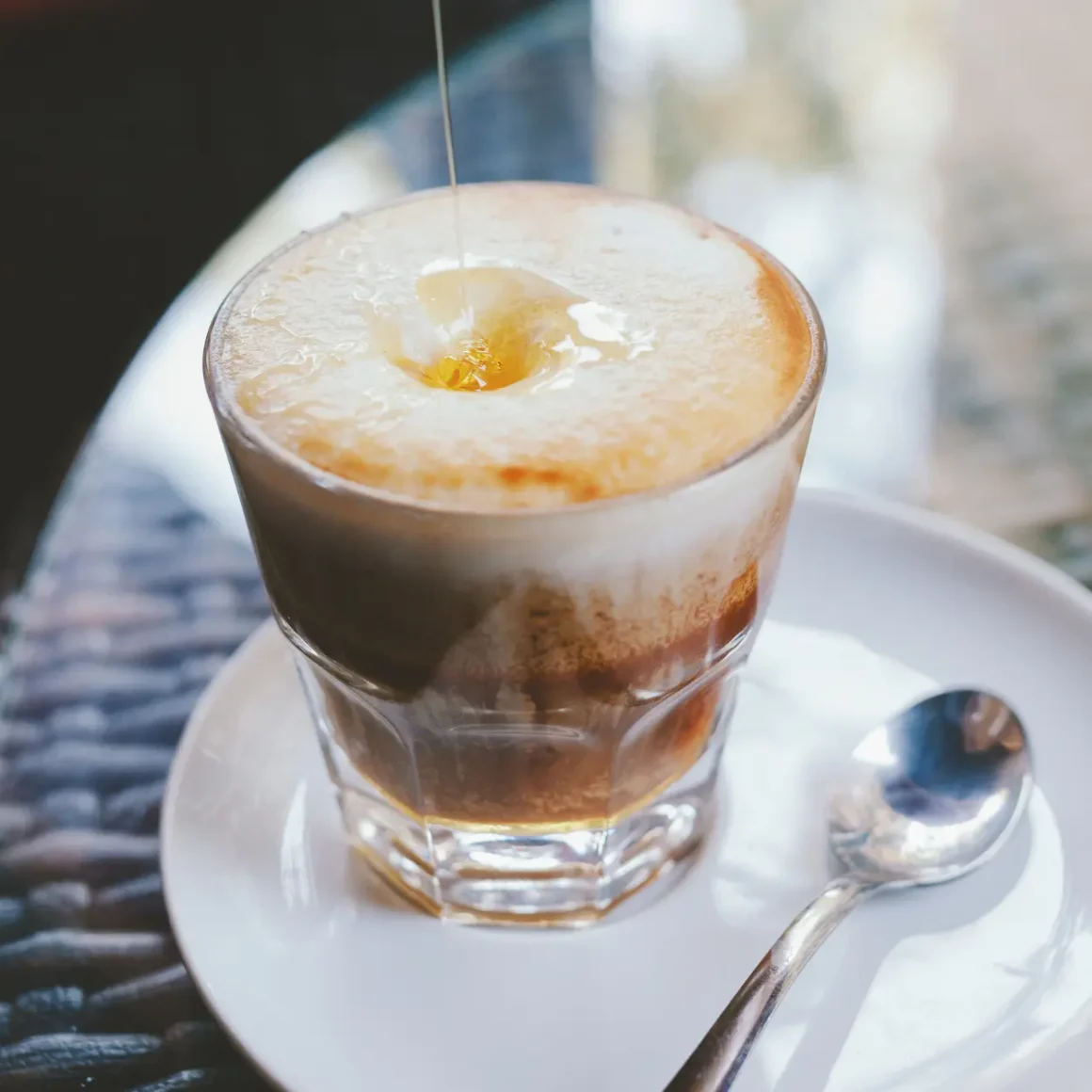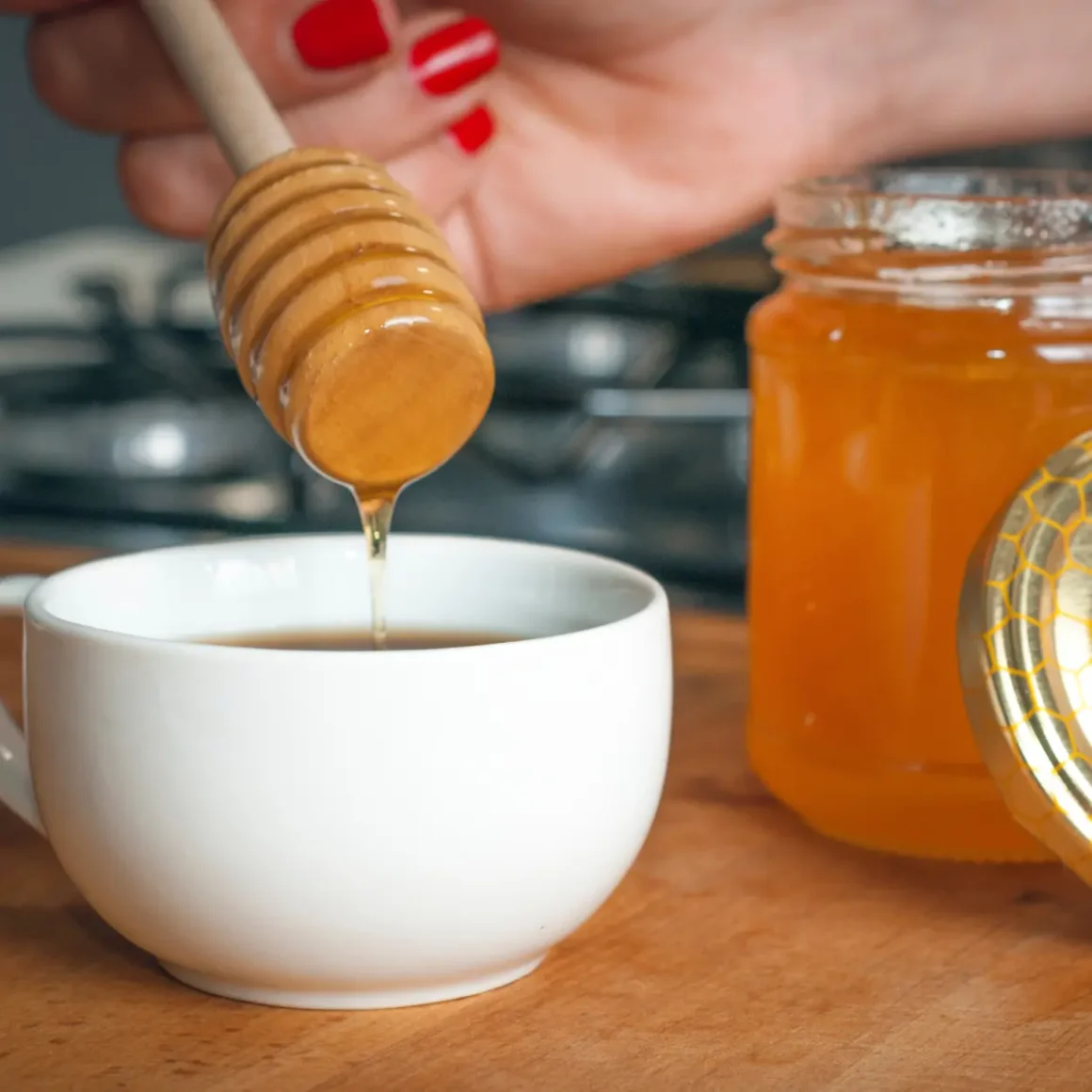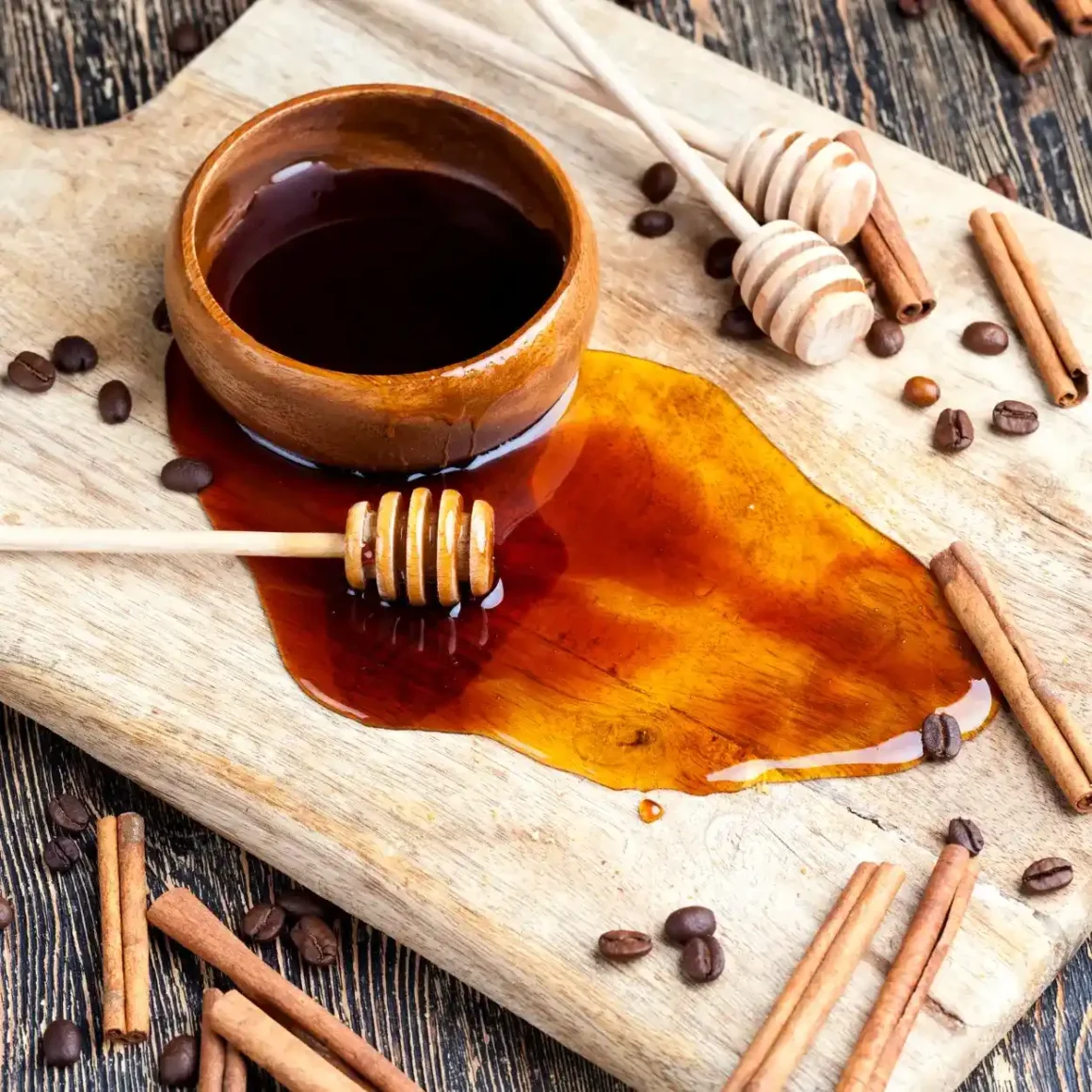In the realm of coffee connoisseurship, the quest for the perfect cup often leads to exploring various sweeteners. Among these, honey stands out as a natural, flavorful, and health-conscious choice. This article delves into the delightful synergy of honey in coffee, exploring how this golden elixir not only enhances the taste of our beloved brew but also brings with it a plethora of health benefits. From its ability to complement different coffee roasts to its nutritional advantages, honey transforms the simple act of sweetening into an art form. Whether you’re a seasoned aficionado or a curious newcomer, understanding the role of honey in coffee opens up a new dimension in the appreciation of this timeless beverage.
Tired of reading? Give your eyes a rest and listen to the article here.
- Introduction & Key Takeaway
- https://app.mysoundwise.com/tracks/17000174628152627e.mp3
- The Sweetness of Honey
- https://app.mysoundwise.com/tracks/17000174966195347e.mp3
- The Science Behind It
- https://app.mysoundwise.com/tracks/17000175265801011e.mp3
- Brewing Techniques
- https://app.mysoundwise.com/tracks/17000175579711016e.mp3
- Health Benefits
- https://app.mysoundwise.com/tracks/17000175894829922e.mp3
- Taste Exploration
- https://app.mysoundwise.com/tracks/17000176183477681e.mp3
- Conclusion & FAQs
- https://app.mysoundwise.com/tracks/17000176499732246e.mp3
Coffee with Honey: Key Takeaway
- Health Benefits: Honey in coffee is a healthy choice, rich in antioxidants and nutrients, offering more than just sweetness by improving overall wellness.
- Flavor Enhancement: The natural sweetness and flavor of honey complement various coffee roasts, balancing acidity and enriching this beverage’s taste.
- Versatility in Coffee Preparations: Honey’s adaptability shines in different styles, from hot brews to cold and espresso, each offering a distinct flavor experience.
- Unique Infusions: Infusing honey with spices like cinnamon or vanilla adds new dimensions to coffee, creating gourmet flavors for diverse palates.
- Eco-Friendly Choice: Choosing honey as a sweetener supports environmental sustainability and bee conservation, making it an eco-conscious option.
The Sweetness of Honey
Honey, a delightful and natural sweetener, has long been cherished for its unique taste and health benefits. Unlike table sugar, honey’s sweetness stems from its natural composition of glucose and fructose. This nectar-derived substance not only adds a touch of sweetness to foods and beverages but also brings with it a host of nutritional benefits.
The Natural Sweetness of Honey

The intrinsic sweetness of honey is attributed to its natural sugars, primarily glucose and fructose. This composition makes honey a versatile sweetener with additional health benefits.
- Composition: Honey consists of about 40% fructose and 30% glucose, with water, sucrose, vitamins, minerals, and antioxidants making up the rest. (1)
- Health Benefits: Unlike processed sugars, honey offers nutritional value, including antioxidants and trace vitamins, beneficial for overall health.
- Sugar Comparison: Compared to table sugar, which is a disaccharide formed from glucose and fructose bonding, honey’s unbounded monosaccharides are metabolized differently by the body, potentially making it a better option for those with blood sugar sensitivities. (2)
When considering adding honey to your diet, it’s essential to understand its natural composition and the advantages it holds over regular sugar, particularly for those sensitive to blood sugar fluctuations.
Types of Honey for Coffee

Selecting the right type of honey for your coffee can enhance your experience. Each variety of honey brings a distinct flavor profile, which can complement or transform the taste of your cup of joe.
- Acacia: Known for its exceptional sweetness, Acacia honey is ideal for those who prefer a sweeter cup of joe. (3)
- Alfalfa: This variety promotes intestinal health and adds a subtle sweetness to your brew.
- Avocado: Contrary to its name, this type comes from avocado blossoms, offering a unique, buttery flavor.
- Blue Gum: Best suited for toast due to its denser texture, but an adventurous choice for this lovely beverage.
- Buckwheat: Rich and potent, it’s more suited for other culinary uses than for this drink.
- Chestnut: Slightly bitter, harvested from chestnut tree nectar, and potentially suitable for diabetics.
- Fireweed: Popular in the USA for its smooth, buttery, and complexly sweet profile, making it a great coffee companion.
Experimenting with different types of honey can uncover delightful combinations, enhancing the flavor profile of your coffee with honey.
Measuring the Perfect Honey Dose

The key to perfecting coffee with honey lies in balancing the sweetness. Understanding the right amount of honey to add can make all the difference in achieving the desired taste and sweetness level.
- Taste Preference: Personal preference plays a significant role in determining the amount of honey. Some may prefer a sweeter taste, while others might opt for just a hint of sweetness.
- Sweetness Comparison: Honey is generally sweeter than sugar due to its higher fructose content. Therefore, you might need less honey than sugar to achieve the same level of sweetness.
- Measurement Guide: A good starting point is using half a teaspoon of honey for every teaspoon of sugar you would typically use. Adjust according to your taste.
Adjusting the amount of honey in your coffee is a matter of personal taste. Start with a small amount and increase as needed to find your perfect balance.
The Science Behind It

The integration of honey into coffee is more than just a matter of taste; it involves a fascinating interplay of chemistry and flavor science. Understanding how honey interacts with coffee on a molecular level can enhance our appreciation of this unique combination.
How Honey Affects Coffee Chemistry
When honey is added to coffee, it does more than sweeten the brew; it alters the coffee’s chemical composition in subtle yet significant ways.
- Sweetness Profile: Honey’s natural sugars, mainly fructose and glucose, interact differently with coffee compared to regular sugar. This interaction can alter the perception of bitterness and other flavor notes in coffee.
- Temperature Considerations: The temperature of the coffee affects how honey dissolves and interacts with the coffee’s compounds, potentially changing the flavor profile.
- Chemical Complexity: Honey adds its own set of compounds to the coffee, including acids and minerals, which can interact with coffee’s natural acids and oils, creating a unique taste experience.
The chemical interplay between honey and coffee leads to a complex and nuanced flavor profile, making honey coffee a distinctive and enjoyable drink.
The Role of Honey in Balancing Acidity
One of the key roles of honey is its ability to balance the natural acidity of the brew, creating a smoother and more harmonious flavor.
- Acidity Neutralization: Honey’s natural sweetness can counteract some of the acidic notes in coffee, particularly in lighter roasts known for their higher acidity.
- Flavor Enhancement: The interaction between honey’s sweetness and coffee’s acidity can highlight certain flavor notes, such as fruity or floral tones, that might otherwise be overshadowed by acidity.
- Consistency in Flavor: Honey provides a consistent sweetening effect, which can be more reliable than sugar in balancing the acidity in different coffee roasts.
Honey’s role in mitigating the acidity of coffee not only makes the drink more palatable but also allows for a fuller appreciation of the coffee’s inherent flavors.
Why Honey Enhances Aromas
Beyond its sweetening effect, honey has the unique ability to enhance the aromatic qualities of coffee, making the sensory experience of drinking honey coffee particularly rich and satisfying.
- Aroma Compounds: Honey contains its own set of volatile compounds that can complement and amplify the natural aromas in a cup of joe.
- Synergistic Effect: When honey is mixed with coffee, it can create new aromatic compounds, enhancing the overall bouquet of the brew.
- Sensory Enhancement: The interaction between the flavors and aromas of honey and coffee can enhance the drinker’s sensory experience, making the drink more aromatic and flavorful.
The addition of honey not only enriches the taste of this delectable beverage but also elevates its aromatic profile, contributing to the overall enjoyment of the drink.
Brewing Techniques
Exploring different techniques for incorporating honey into coffee can transform an ordinary cup into an extraordinary experience. Each brewing method offers unique opportunities to blend the rich flavors of coffee with the sweet, nuanced taste of honey.
Adding Honey to Hot Coffee
Incorporating honey into hot coffee is an art that enhances the beverage’s flavor and aroma, creating a comforting and indulgent drink.
- Preparation: Start with freshly roasted coffee beans, ground using a burr grinder for consistency.
- Brewing Method: Brew your coffee using your preferred method, like pour-over, drip, or espresso, to achieve the desired strength.
- Honey Integration: Mix honey with a bit of warm milk or water in a separate container, ensuring it dissolves completely for even distribution.
- Combining Ingredients: Pour the honey mixture into your freshly brewed coffee. Optionally, add a sprinkle of cinnamon for an extra flavor dimension.
Putting honey in, especially when it’s hot, allows for a seamless blend of flavors, making each sip a perfect balance of sweetness and strength.
Cold Brews with a Hint of Honey

Adding honey to cold brew coffee is a refreshing twist that can bring out unique flavor profiles, perfect for warmer days or as a chilled treat.
- Cold Brew Preparation: Start with a high-quality cold brew, which you can prepare at home or purchase pre-made.
- Honey Syrup: Create a syrup by dissolving honey in a small amount of warm water, ensuring it integrates smoothly into the cold brew.
- Assembling the Drink: Pour the cold brew over ice, then add the honey syrup. Adjust the sweetness according to taste.
- Milk Addition: For a creamier texture, stir in your preferred amount of milk or a milk alternative.
A cold brew with a hint of honey offers a refreshing, sweetly nuanced alternative to traditional iced coffee, perfect for sipping on a sunny day.
Espresso and Honey: A Surprising Duo

Pairing espresso with honey might seem unconventional, but this combination can create a surprisingly harmonious and rich beverage.
- Espresso Preparation: Brew a strong, rich espresso, which will serve as the robust base for the drink.
- Honey Addition: Before brewing, add a teaspoon of honey directly into the espresso cup, allowing the heat of the espresso to naturally dissolve the honey.
- Stirring: Once the espresso is brewed, stir thoroughly to ensure the honey is fully incorporated, creating a smooth and sweet espresso experience.
- Optional Enhancements: Experiment with adding a dash of milk or a sprinkle of cinnamon for additional layers of flavor.
Espresso and honey form a delightful duo, offering a unique and sophisticated twist on the classic espresso shot, perfect for those looking to explore new flavor territories.
Health Benefits
While often sought after for its sweetness, honey’s value extends far beyond its flavor. Packed with a myriad of health benefits, honey, especially when added to this delightful beverage, can contribute significantly to a healthier lifestyle.
Honey as a Nutritious Addition

Honey stands out as a superior sweetener, not just for its taste but also for its nutritional profile, making it a beneficial addition to your diet.
- Caloric Content: Although honey has a higher caloric content than sugar, with about 21 calories per teaspoon, its health benefits outweigh this aspect.
- Nutritional Value: Honey is rich in vitamins and minerals, such as Calcium and Vitamin C, which are not found in regular sugar. (4)
- Natural Composition: Unlike processed sugars, honey contains natural sugars like fructose and glucose, making it a healthier alternative.
Integrating honey into your diet, particularly in this beverage, offers a nutritious edge, providing essential nutrients while satisfying your sweet tooth.
Antioxidant Properties

One of the most significant health benefits of honey is its antioxidant properties, which are amplified when combined with coffee.
- Reducing Unhealthy Cells: Antioxidants in honey and coffee work synergistically to reduce harmful cells in the body, which can lead to various health issues if left unchecked.
- Healthier Alternative: Opting for honey over sugar not only enhances flavor but also contributes to better health due to these antioxidant properties.
- Long-term Benefits: Regular consumption of honey in coffee can contribute to a reduction in oxidative stress and inflammation, promoting overall well-being.
The antioxidant power of honey in coffee benefits not just immediate health but also contributes to long-term wellness and disease prevention.
Honey in Coffee for Sore Throat Relief

Beyond its nutritional and antioxidant benefits, honey, particularly when added to coffee, can serve as a soothing remedy for a sore throat.
- Soothing Effect: The natural consistency and composition of honey can coat and soothe the throat, providing relief from irritation and pain.
- Combating Infections: Honey’s antibacterial qualities aid in fighting infections that can cause sore throats.
- Enhancing Immunity: Regular consumption of honey in coffee can bolster the immune system, helping to prevent sore throat occurrences.
Using honey not only enhances the drink’s flavor but also offers a natural and effective way to soothe and prevent sore throats, highlighting one of the many honey in coffee benefits.
Taste Exploration
The world of this delectable beverage is rich and diverse, offering endless possibilities for flavor exploration. When honey is added to the mix, it opens up a new realm of taste experiences, enhancing and transforming the coffee’s profile in delightful ways.
Coffee Varieties that Pair Best with Honey

Choosing the right coffee variety to pair with honey can significantly influence the taste experience. Certain coffee types harmonize wonderfully with honey’s sweetness, creating a perfect balance.
- Light Roasts: Known for their higher acidity and fruity notes, light roasts pair well with honey, balancing the acidity with sweetness.
- Medium Roasts: These offer a balanced flavor, and the addition of honey complements their inherent sweetness and body, enhancing the overall taste.
- Dark Roasts: With their bold and robust flavors, dark roasts can benefit from honey’s sweetness, which softens the bitterness and brings out hidden flavors.
Experimenting with different coffee varieties when adding honey can lead to discovering your perfect coffee with honey combination, catering to your personal taste preferences.
Infusing Honey with Spices for Unique Tastes

Infusing honey with various spices can create unique flavor profiles, elevating the cup of joe experience to a whole new level.
- Cinnamon-Infused Honey: Adds a warm and spicy note, perfect for enhancing the natural flavors of coffee.
- Vanilla-Infused Honey: Brings a sweet and aromatic quality, complementing both light and dark roasts.
- Ginger-Infused Honey: Offers a sharp, spicy kick, ideal for adding a zing to your morning cup.
These honey infusions add depth and complexity to coffee, providing an exciting and unique tasting experience that goes beyond the ordinary.
Coffee Shops’ Secret Honey Recipes

Many coffee shops have secret recipes that use honey to create signature drinks, attracting customers with their unique and delicious flavors.
- Honey Latte: A popular choice, combining steamed milk with espresso and a hint of honey, creating a smooth and sweet treat.
- Honey Cold Brew: A refreshing option, blending cold brew coffee with honey syrup, perfect for hot summer days.
- Spiced Honey Mocha: A winter favorite, combining chocolate, spices, and honey with coffee for a comforting and indulgent drink.
These secret recipes showcase the versatility of coffee with honey, offering customers a unique taste experience that can’t be found elsewhere.
Conclusion
In conclusion, the addition of honey in coffee emerges not just as a mere alternative to traditional sweeteners, but as a holistic enhancement to the coffee-drinking experience. Through our exploration of its diverse applications, from the perfect pairing with various coffee roasts to its infusion with spices for unique flavors, honey has proven its versatility. Furthermore, its health benefits, including antioxidant properties and sore throat relief, add layers of value beyond taste. Coffee enthusiasts who embark on this sweet journey are rewarded with more than just a satisfying cup; they engage in a healthier, more flavorful, and environmentally conscious practice. Embracing honey is, therefore, not just a choice but a celebration of nature’s bounty, enriching the ritual of coffee drinking with every spoonful.
FAQ
How can I mix honey and coffee without clumping?
To prevent clumping, mix honey with a small amount of warm water or milk before adding it to the coffee.
Can honey enhance the flavor of my coffee?
Yes, honey can enhance the flavor of coffee by adding a natural sweetness and unique taste profile.
What are the best coffee and honey combinations?
Light and medium roasts pair well with honey, balancing acidity and sweetness, while dark roasts benefit from honey's ability to soften bitterness.
Are there any potential downsides to using honey in coffee?
The main downside is honey's higher calorie content compared to sugar, and it may not suit those with fructose intolerance.















